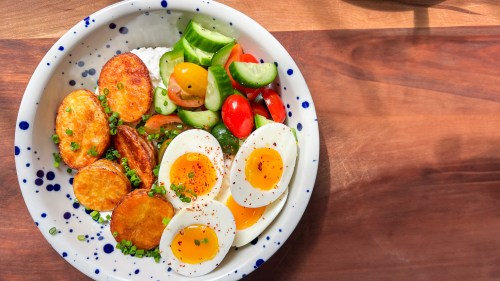This Apple-Radish Kimchi Recipe Is Loaded With Flavor and Gut-Loving, Digestion-Boosting Benefits
A delicious radish kimchi recipe from the curator and head of education at Museum Kimchikan, plus kimchi's significance in Korean cuisine.

As a vocal fan of all things gut health and Korean cuisine, I absolutely *had* to sign up for a kimchi-making class at Museum Kimchikan during my first trip to Seoul this past fall. Sadly, I wasn’t able to eat the full box of kkakdugi (cubed radish kimchi) before I caught a flight back to Los Angeles, but I made sure to keep the recipe on hand so I could make it again (and again) once I got back home. And let me tell you: This ultra fresh DIY kimchi was in a league of its own compared to types I buy at the grocery store or enjoy at Korean restaurants… though, of course, I still love and eat them all.
Experts in This Article
I hope you’ll take my word for it and check out the cubed radish kimchi recipe below. But first: some context on kimchi’s significance in South Korea’s culinary heritage.
Kimchi’s legacy in Korean cuisine
Kimchi’s cultural significance can’t be understated. After all, it’s the national dish of South Korea, and I learned in my class that there are over 200 types of kimchi to enjoy. There are even different types of kimchi based on varieties of a specific veggie at hand. For instance, we made kkakdugi with autumn radish, but other types of radish kimchi include dongchimi (water-based radish kimchi) and yeolmu kimchi (young radish kimchi). Plus, there are very specific seasonal cycles, rituals, and tools for making it—as well as specific refrigerators designed for kimchi only.
“Historically, kimchi was made in large quantities to eat vegetables and be healthy during the cold winter,” says Jungmo An, curator and head of education at Museum Kimchikan. “Making large quantities of kimchi together with family and neighbors is called the kimjang culture,” which she says originated in older agricultural society but lives on through the present day. This collective practice, which takes place in late autumn when temperatures drop to about 39°F, “reaffirms Korean identity and is an excellent opportunity for strengthening family cooperation,” reads one description at the museum. “Kimjang is also an important reminder for many Koreans that human communities need to be in harmony with nature.”
An continues to say that kimchi is integral to Korean dining in terms of it being a culinary staple and a nutritional powerhouse. “The Korean table is represented by three [foods]: rice, soup, and kimchi. Rice, a carbohydrate, is the main ingredient, and salt is essential to help digest the rice. So eating soup with salt and kimchi, which has a base of salted vegetables, are important,” says An.
“Kimchi is delicious, nutritious, and can be stored for a long time,” An adds. With these advantages alone, kimchi is a food that can be enjoyed by any and all—no matter their class, region, or other markers of identity. (Not to mention that kimchi helps to up your intake of veggies and gut-boosting fermented foods, which can lead to major benefits including but not limited to stronger immunity, improved digestive health, and less inflamed skin.)
Recipe tips and modifications
Here are a few helpful FYIs to keep in mind when prepping this cubed radish kimchi recipe:
- We used autumn radish in my kimchi class. Since it was in peak season, it didn’t need to be salted and we instead added salt to the paste. If you use a different type of radish, you’ll need to salt the cubes for 30 minutes (if they’re small and sweet) or for up to two hours (if they’re big and bitter). In these cases, An says you can skip adding roasted salt to the paste.
- If you like your kimchi more mild than spicy, limit the measure of gochugaru (Korean chili) flakes in your kimchi paste to two tablespoons only.
- If you don’t have plum extract or pear juice on hand, An says you can substitute with sugar or onion juice.
- If possible, store kimchi in the refrigerator at a temperature of 37.5°F to 41°F. Try to wait for two to three days before eating it to better allow the seasoning to spread.
- Enjoy your cubed radish kimchi on its own or with rice. An says it also pairs well with soups and meat dishes such as galbijjim (braised beef short ribs) and tonkatsu (fried pork cutlet).
Cubed radish kimchi recipe
Ingredients1 radish1 red apple1 bunch chives1 bunch minari (water parsley)3 Tbsp fine gochugaru
For the kimchi paste:3 Tbsp gochugaru flakes1 tsp roasted salt1 Tbsp minced garlic1 tsp minced ginger2 Tbsp plum extract1 Tbsp pear juice1 Tbsp sticky rice paste1 Tbsp salted shrimp
Instructions1. Cut the radish into one-inch cubes. Salt and let sit if needed (refer to the first tip above).
2. Cut the apple into one-inch cubes. Cut the water parsley and chives in one-inch slices. Add all produce to a large bowl and dye them with fine gochugaru.
3. Mince the salted shrimp (or use a food processor). In a separate bowl, mix all kimchi paste ingredients together.
4. Mix vegetables and kimchi paste; toss and coat well.
5. Store kimchi in an airtight container. Let ferment at room temperature for 24 hours before storing it in the refrigerator.
Sign Up for Our Daily Newsletter
Get all the latest in wellness, trends, food, fitness, beauty, and more delivered right to your inbox.
Got it, you've been added to our email list.










